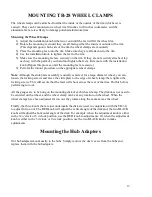
4
GENERAL ALIGNMENT PROCEDURE
The following section is an overall guide for performing an alignment with the TR-12. The steps
listed below are meant to give a basic understanding of what procedures are used, and how they
are performed, to accomplish wheel alignment. The steps given should generally be followed in
the same order as they have been placed. It may also be helpful keep these procedures close at
hand.
Also because of the many varieties of racecars there are supplemental procedures for the
different types of racecars. Please contact Tru-Line for an updated list of supplemental procedures
if you do not see a supplemental procedure for your type of racecar.
Note:
Prior to any alignment it must be decided what type of alignment is to be performed:
i.e. Two-wheel Centerline, Two-wheel Thrust Angle or a full Four-wheel alignment. This will
determine the procedure required.
There are 3 distinct types of alignment:
Two-wheel Centerline
Two-wheel Thrust Angle
Four-wheel (all four wheels have adjustments available)
Each of these alignments requires a different set of procedures. Specific procedures for each of
these alignments are given in the following sections.
Overview
1)
Check calibration of the TR-12 Series alignment system and, if necessary, recalibrate.
2)
Put the vehicle on a rack, or other appropriate platform. Perform standard pre-alignment
checks and inspections.
Remember
, no alignment can be properly done with loose
suspension parts.
3)
Mount the TR-28 wheel clamps on all four wheels, with the installation knob on top of the
tire. The aluminum feet can be mounted on either the inside or outside of the rims,
whichever is more convenient. Make sure the wheel clamps are securely in place. You may
use hub adapters in place of the TR-28 wheel clamps.
4)
To adjust run out using the TR-30 EZ Check gauge:
a)
Raise the vehicle, so the wheels can rotate freely.
b)
Place the TR-30 on the disk located on the TR-28 wheel clamp.
c)
Using the TR-30 gauge, and with the adjustment knob on the TR-28 at a 3 o’clock
position, set the caster bubble to zero.
d)
Rotate the wheel so that the installation knob is at a 9 o’clock position.
e)
Using the RED zero knob on the TR-28 wheel clamp adjust the bubble on the TR-
30 halfway to the 0 position using the numbers on the caster scale.
f)
Rotate the TR-28 to a 12 o’clock position and adjust caster bubble to zero again.
g)
Rotate the wheel to the 6 o’clock position and adjust the bubble too halfway
between zero and the reading using the two knobs not yet adjusted on the TR-28
clamp.
h)
With the TR-30 held in a level position with one hand (do not grasp or hold tightly),
rotate the wheel one full turn while watching the caster bubble. Here the bubble
should not move more than 1/8 of a bubble. If the bubble moves more than 1/8 of a
bubble repeat the procedure



















